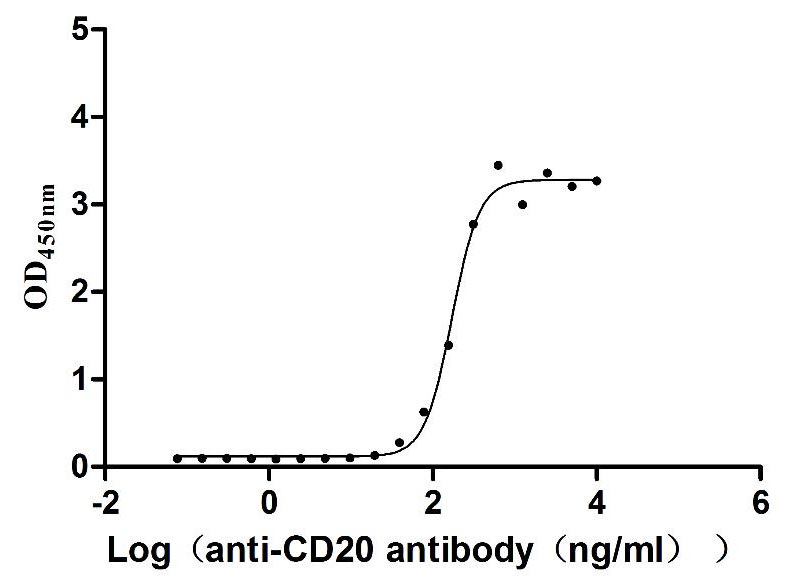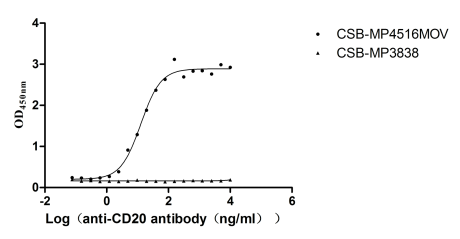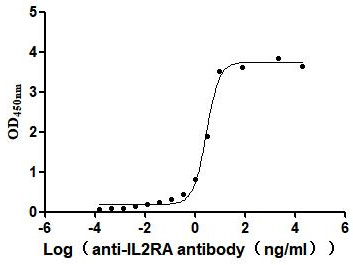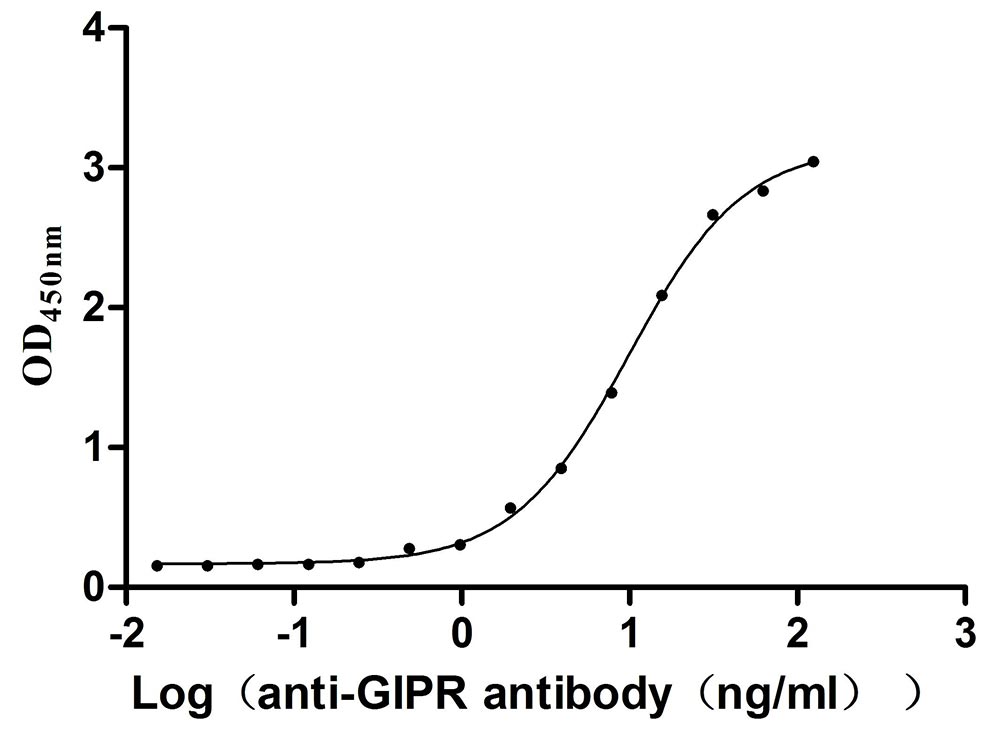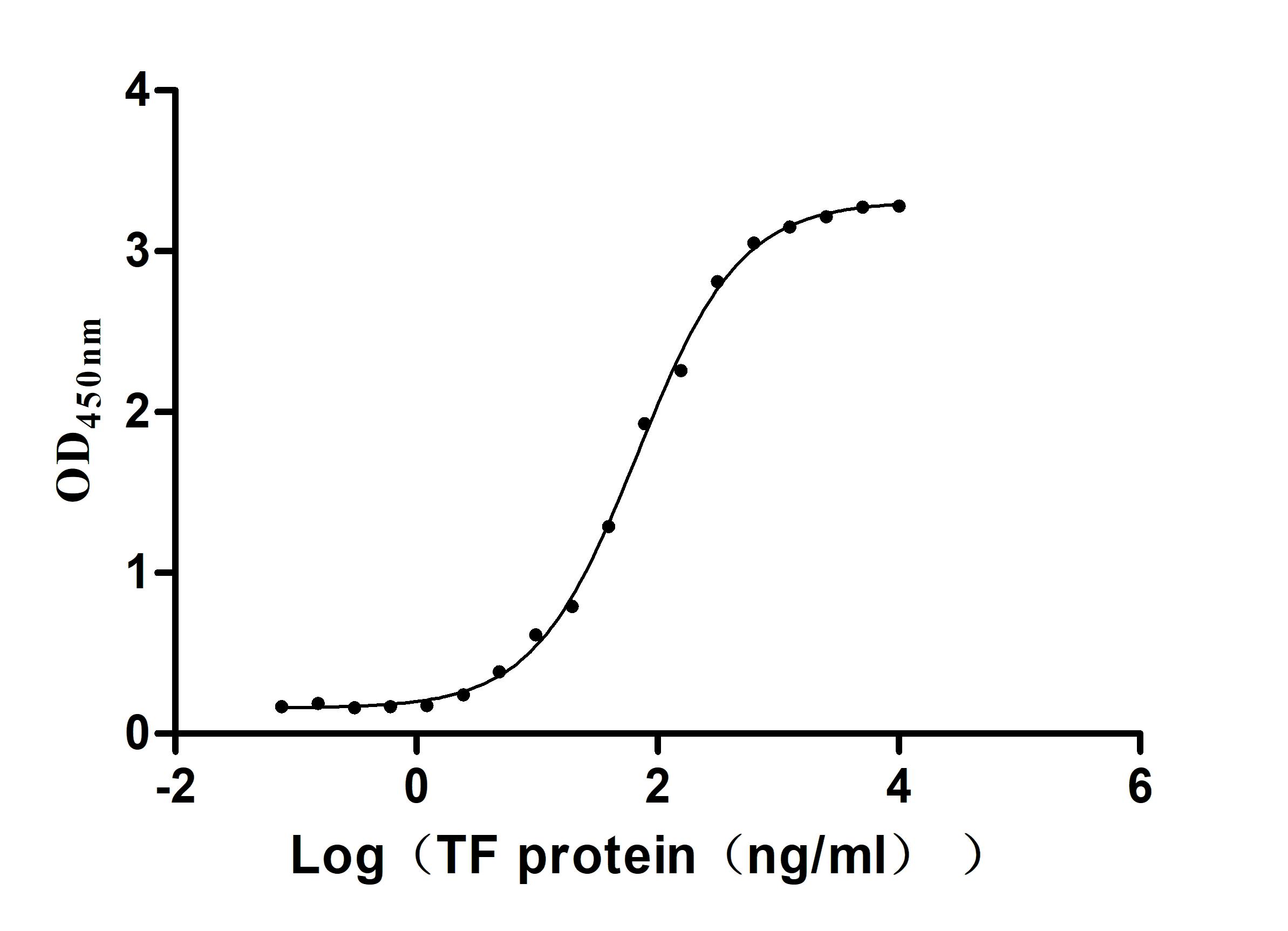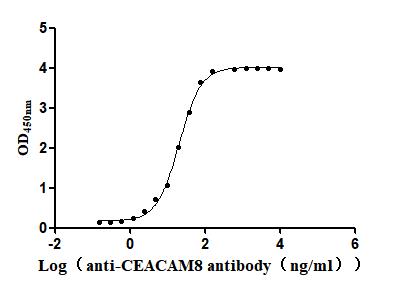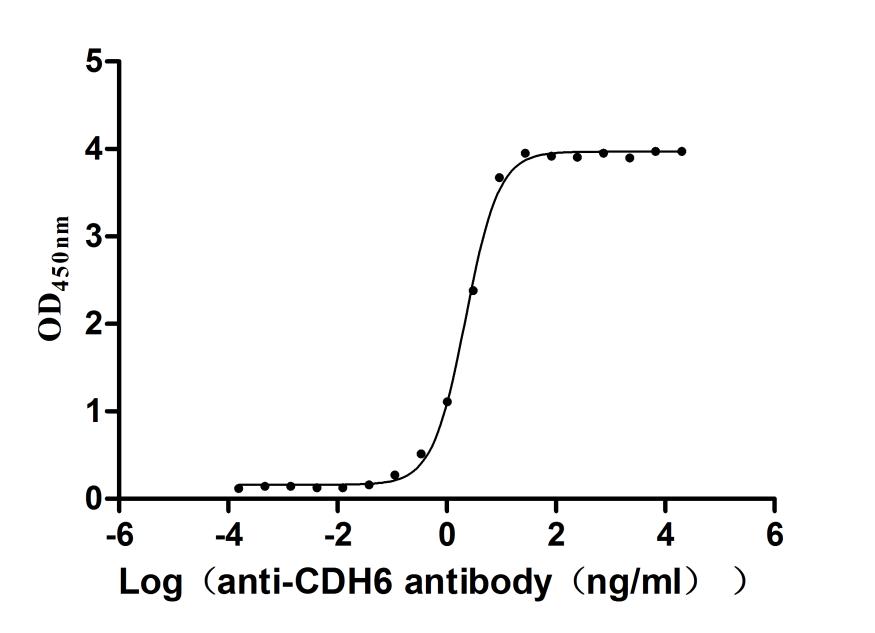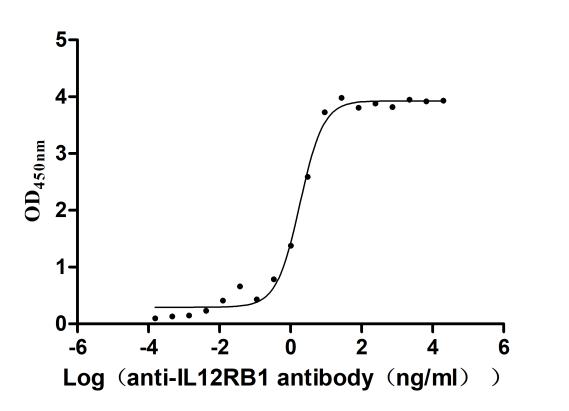Recombinant Human Ubiquitin-protein ligase E3A (UBE3A E6AP EPVE6AP HPVE6A)
-
中文名稱:
-
貨號:CSB-YP025488HU
-
規(guī)格:
-
來源:Yeast
-
其他:
-
中文名稱:
-
貨號:CSB-EP025488HU
-
規(guī)格:
-
來源:E.coli
-
其他:
-
中文名稱:
-
貨號:CSB-EP025488HU-B
-
規(guī)格:
-
來源:E.coli
-
共軛:Avi-tag Biotinylated
E. coli biotin ligase (BirA) is highly specific in covalently attaching biotin to the 15 amino acid AviTag peptide. This recombinant protein was biotinylated in vivo by AviTag-BirA technology, which method is BriA catalyzes amide linkage between the biotin and the specific lysine of the AviTag.
-
其他:
-
中文名稱:
-
貨號:CSB-BP025488HU
-
規(guī)格:
-
來源:Baculovirus
-
其他:
-
中文名稱:
-
貨號:CSB-MP025488HU
-
規(guī)格:
-
來源:Mammalian cell
-
其他:
產(chǎn)品詳情
-
純度:>85% (SDS-PAGE)
-
基因名:
-
Uniprot No.:
-
別名:Ubiquitin-protein ligase E3A; EC 2.3.2.26; E6AP ubiquitin-protein ligase; HECT-type ubiquitin transferase E3A; Human papillomavirus E6-associated protein; Oncogenic protein-associated protein E6-AP; Renal carcinoma antigen NY-REN-54; UBE3A E6AP EPVE6AP HPVE6A
-
種屬:Homo sapiens (Human)
-
蛋白標(biāo)簽:Tag?type?will?be?determined?during?the?manufacturing?process.
The tag type will be determined during production process. If you have specified tag type, please tell us and we will develop the specified tag preferentially. -
產(chǎn)品提供形式:Liquid or Lyophilized powder
Note: We will preferentially ship the format that we have in stock, however, if you have any special requirement for the format, please remark your requirement when placing the order, we will prepare according to your demand. -
復(fù)溶:We recommend that this vial be briefly centrifuged prior to opening to bring the contents to the bottom. Please reconstitute protein in deionized sterile water to a concentration of 0.1-1.0 mg/mL.We recommend to add 5-50% of glycerol (final concentration) and aliquot for long-term storage at -20℃/-80℃. Our default final concentration of glycerol is 50%. Customers could use it as reference.
-
儲存條件:Store at -20°C/-80°C upon receipt, aliquoting is necessary for mutiple use. Avoid repeated freeze-thaw cycles.
-
保質(zhì)期:The shelf life is related to many factors, storage state, buffer ingredients, storage temperature and the stability of the protein itself.
Generally, the shelf life of liquid form is 6 months at -20°C/-80°C. The shelf life of lyophilized form is 12 months at -20°C/-80°C. -
貨期:Delivery time may differ from different purchasing way or location, please kindly consult your local distributors for specific delivery time.Note: All of our proteins are default shipped with normal blue ice packs, if you request to ship with dry ice, please communicate with us in advance and extra fees will be charged.
-
注意事項:Repeated freezing and thawing is not recommended. Store working aliquots at 4°C for up to one week.
-
Datasheet :Please contact us to get it.
相關(guān)產(chǎn)品
靶點(diǎn)詳情
-
功能:E3 ubiquitin-protein ligase which accepts ubiquitin from an E2 ubiquitin-conjugating enzyme in the form of a thioester and transfers it to its substrates. Several substrates have been identified including the ARNTL/BMAL1, ARC, RAD23A and RAD23B, MCM7 (which is involved in DNA replication), annexin A1, the PML tumor suppressor, and the cell cycle regulator CDKN1B. Additionally, may function as a cellular quality control ubiquitin ligase by helping the degradation of the cytoplasmic misfolded proteins. Finally, UBE3A also promotes its own degradation in vivo. Plays an important role in the regulation of the circadian clock: involved in the ubiquitination of the core clock component ARNTL/BMAL1, leading to its proteasomal degradation. Acts as transcriptional coactivator of progesterone receptor PGR upon progesterone hormone activation. Acts as a regulator of synaptic development by mediating ubiquitination and degradation of ARC. Synergizes with WBP2 in enhancing PGR activity.; (Microbial infection) Catalyzes the high-risk human papilloma virus E6-mediated ubiquitination of p53/TP53, contributing to the neoplastic progression of cells infected by these viruses.
-
基因功能參考文獻(xiàn):
- UBE3A regulates an imprinted gene network involving DNA methylation and H2A.Z deposition. PMID: 28925810
- ANCR overexpression inhibited NSCLC cell migration and invasion and downregulated TGF-beta1 expression, while TGF-beta1 treatment showed no significant effects on ANCR expression but promoted NSCLC cell migration and invasion. PMID: 30154397
- Results from a study on gene expression variability markers in early-stage human embryos shows that UBE3A is a putative expression variability marker for the 3-day, 8-cell embryo stage. PMID: 26288249
- The divergence of E6 proteins from either MAML1 or E6AP binding preference is a major event in papillomavirus evolution. PMID: 29281732
- Data report the establishment and thorough characterization of a new iPSC line from a patient with Angelman syndrome, harboring a defined three-base pair deletion within the maternally inherited UBE3A allele. Using computer modeling of the mutant protein, a local destabilization around the catalytic cleft of UBE3A was proposed, likely impairing the binding of substrates. PMID: 27484051
- We demonstrate that E6AP regulates p27 expression by inhibiting its transcription in an E2F1-dependent manner. Concomitant knockdown of E6AP and p27 partially restores PC cell growth, supporting the contribution of p27 to the overall effect of E6AP on prostate tumorigenesis. PMID: 28477016
- novel IVS15-1G>C and c.2540 C>T mutations of the UBE3A gene probably underlie the AS in the two families PMID: 29188609
- Findings show neuronal overexpression of Ube3a isoform 2 causes phenotypes translatable to neurodevelopmental disorders. PMID: 29016856
- This study demonstrate the importance of the N-terminal domain of full length E6AP for diubiquitin chain specificity. PMID: 29288669
- our data demonstrates that E6AP facilitates ubiquitination and subsequent degradation of G-CSFR leading to attenuation of its downstream signaling and inhibition of granulocytic differentiation. PMID: 28578910
- Novel intragenic deletions within the UBE3A gene have been reported in two unrelated patients with Angelman syndrome. PMID: 29162042
- Data suggest ordered binding of UBCH7-ubiquitin to E6AP Site 1 (for E6AP-Cys820/ubiquitin thioester formation) and E6AP Site 2 (for subsequent chain elongation); proximal indexation accounts for symmetric structure of E6AP, requirement for oligomerization in polyubiquitin chain formation, and mechanistic rationale for Cys820-ubiquitin thioester as platform in chain assembly. (UBCH7 = ubiquitin-conjugating enzyme UBCH7) PMID: 28924046
- E6AP (UBE3A) abundance is down-regulated in a proportion of NSCLC (non-small cell lung cancer) patients, and this correlates with low p16INK4a in tumors and worse overall survival. PMID: 28074012
- study has broad implications for human disorders associated with UBE3A gain or loss of function and suggests that dysfunctional UBE3A might affect additional proteins and pathways that are sensitive to proteasome activity PMID: 28559284
- We found that KD of E6AP attenuates cancer cell growth by promoting cellular senescence in vivo, which correlates with restoration of tumor suppression by PML. PMID: 27641331
- HCV core protein inhibits E6AP expression via DNA methylation to protect itself from ubiquitin-dependent proteasomal degradation and stimulate virus propagation. PMID: 27317649
- E6AP suppresses breast cancer metastasis by regulating actin cytoskeleton remodeling through the control of ECT2 and Rho GTPase activity. PMID: 27231202
- Dube3a is neither imprinted nor preferentially expressed from the maternal allele in fly neurons. PMID: 27599063
- The ubiquitylation of beta-catenin by E6AP was dependent on its E3 ubiquitin ligase activity, but it was proteasome-independent and did not require HPV16-E6. PMID: 27902311
- All patients with Angelman syndrome based on a deletion had epilepsy. Epilepsy was present in 3/4 children with UBE3A mutation. Laughter-induced postural muscle tone loss occurred only among deletion cases PMID: 27323320
- The results of Trans-well and cell scratch tests showed that when ANCR expression was decreased, the invasion and migration abilities of SW620 cells significantly declined (both P < 0.05). In conclusion, these results suggest that lncRNA-ANCR could influence the invasion and migration of CRC cells by specifically binding to EZH2. PMID: 27983539
- There were total 55 molecularly confirmed Angelman syndrome(AS) between January 1995 to September 2015 for review. 65.5% of them were caused by maternal microdeletion, 10.9% by paternal uniparental disomy, 3.6% by imprinting center defect and 14.5% by UBE3A gene mutation PMID: 27174604
- The observation of Dup15q syndrome in individuals with maternally but not paternally inherited duplications of chromosome 15q11-q13, suggest that UBE3A drives the Angelman syndrome phenotype in this disorder. (Review) PMID: 26585570
- our results indicate that CSN6 is a positive regulator of E6AP and is important for cervical cancer development. PMID: 26318036
- Stable over-expression of E6-AP increases the proliferation and invasion of prostate tumor cells. PMID: 26261538
- Impairments in both synaptic plasticity and fear conditioning memory in UBE3A-deficient mice are significantly ameliorated by blocking SK2. These results elucidate a mechanism by which UBE3A directly influences cognitive function. PMID: 26166566
- Study describes an upstream regulatory mechanism for UBE3A and provides a comprehensive understanding of how missense mutations linked to Angelman syndrome and autism affect UBE3A protein function. PMID: 26255772
- The miR-375-UBE3A axis is important in modulating radiosensitivity of HR-HPV (+) cervical cancer. PMID: 26224081
- UBE3A dampens ERK pathway signalling in HPV E6 transformed HeLa cells PMID: 25815718
- crystal structure of a ternary complex comprising full-length human papilloma virus type 16 (HPV-16) E6, the LxxLL motif of E6AP and the core domain of p53 PMID: 26789255
- UBE3A may regulate the expression of annexin A2, resulting in promotion of proliferation and invasion and suppression of apoptosis in breast cancer cells. PMID: 25816213
- The activity of E6AP is controlled by noncovalent interactions with ubiquitin and allosteric activators such as the HPV E6 oncoprotein. PMID: 26216987
- E6-AP Lys(847) is required for the formation of Lys(48)-linked polyubiquitin chains. PMID: 26161728
- Mutated catalytically inactive forms of UBE3A may cause defects in overall proteasome function. PMID: 25633294
- Semirhythmic myoclonus is common in patients with Angelman syndrome caused by UBE3A mutations, and such myoclonic events are often life disabling PMID: 24796722
- study identifies E6AP and PML as potential prognostic markers in localized prostate carcinoma and supports a role for E6AP in driving the downregulation or loss of PML expression in prostate carcinomas PMID: 25231954
- 111 (4.41%) probands had a nucleotide change classified as pathogenic or strongly favored to be pathogenic, 29 (1.15%) had a VUS, and 126 (5.0%) had a UBE3A nucleotide change classified as benign or strongly favored to be benign PMID: 25212744
- Identification of 50 proteins in the Drosophila brain that respond to changes in expression levels of the Drosophila ortholog of UBE3A, Dube3a, in neurons. Some of these genes responded at the transcription level. PMID: 23626758
- Since maternal interstitial duplications result in ASD but paternals do not consistently cause ASD this study implicates the maternally expressed UBE3A gene as the driving force behind the ASD phenotype in 15q Duplication syndrome. PMID: 23495136
- This study identified E6AP as a novel regulator of the Wnt signaling pathway, capable of cooperating with E6 in stimulating or augmenting Wnt/beta-catenin signaling, thereby possibly contributing to HPV carcinogenesis. PMID: 25262469
- Within all subgroups, expressive language performance was significantly reduced when compared to the receptive performance. PMID: 24656292
- The data suggest that UBE3A imprinting in neurons only requires UBE3A-ATS expression, and no other neuron-specific factors. PMID: 24363065
- In this review, a role for E6AP is defined in the pathobiology of neuro-developmental and neuro-aging diseases. PMID: 24091829
- The results of this study indicate the efficiency of the data integration and the significant interrelation between Ube3a and p53 in myocardial cells during apoptosis. PMID: 24337433
- DAta indicate that E6-associated protein (E6AP)/UBE3A oligomerization is required for polyubiquitin degradation signal assembly and that changes in oligomerization regulates such activity. PMID: 24273172
- pro-IL-1beta is degraded in a proteasome-dependent manner in E6-positive cells which is mediated via the ubiquitin ligase E6-AP and p53. PMID: 23935506
- This study screening UBE3A was performed in 43 patients who were referred for Angelman Syndrome but whom previous molecular diagnostic tests failed to provide a diagnosis. PMID: 23416059
- E6AP targeted C/EBPalpha protein degradation may provide a possible explanation for both loss of expression and/or functional inactivation of C/EBPalpha in myeloid leukemia. PMID: 23598402
- E6AP is an important regulator of ROS-mediated cellular senescence and cell death. PMID: 22986523
- Arc protein levels are controlled by E6AP at the transcriptional rather than at the posttranslational level. PMID: 23671107
顯示更多
收起更多
-
相關(guān)疾病:Angelman syndrome (AS)
-
亞細(xì)胞定位:Cytoplasm. Nucleus.
-
數(shù)據(jù)庫鏈接:
Most popular with customers
-
Recombinant Dog B-lymphocyte antigen CD20 (MS4A1)-VLPs (Active)
Express system: Mammalian cell
Species: Canis lupus familiaris (Dog) (Canis familiaris)
-
Recombinant Macaca fascicularis Membrane spanning 4-domains A1 (MS4A1)-VLPs (Active)
Express system: Mammalian cell
Species: Macaca fascicularis (Crab-eating macaque) (Cynomolgus monkey)
-
Recombinant Human Interleukin-2 receptor subunit alpha (IL2RA), partial (Active)
Express system: Mammalian cell
Species: Homo sapiens (Human)
-
Recombinant Mouse Gastric inhibitory polypeptide receptor (Gipr), partial (Active)
Express system: Mammalian cell
Species: Mus musculus (Mouse)
-
Recombinant Human Serotransferrin(TF) (Active)
Express system: Mammalian cell
Species: Homo sapiens (Human)
-
Recombinant Human Carcinoembryonic antigen-related cell adhesion molecule 8(CEACAM8) (Active)
Express system: Mammalian cell
Species: Homo sapiens (Human)
-
Recombinant Macaca fascicularis Cadherin 6(CDH6),partial (Active)
Express system: Mammalian cell
Species: Macaca fascicularis (Crab-eating macaque) (Cynomolgus monkey)
-
Recombinant Human Interleukin-12 receptor subunit beta-1(IL12RB1),partial (Active)
Express system: Mammalian cell
Species: Homo sapiens (Human)


